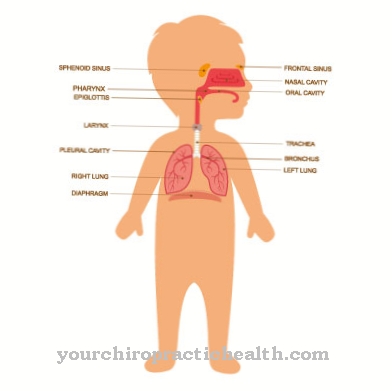The Pulley lesion is damage to the annular ligament of the long biceps tendon as it enters the biceps groove. It occurs as a result of an accident injury or through weakening of the tendon attachment that has become brittle with age. The therapy of choice is tenotomy.
What is a pulley lesion?

© rob3000 - stock.adobe.com
The Pulley lesion is damage to the long biceps tendon in the shoulder joint. The long biceps tendon takes its place at the upper edge of the shoulder joint socket, from where it runs freely through the joint interior, which it finally leaves through the biceps groove of the humerus head.
Compared to the short biceps tendon, which is located outside the shoulder joint, the long biceps tendon is prone to injuries and overloads due to its raised course within the joint. The section in the shoulder joint that it traverses is called the pulley system. This is a connective tissue loop made up of different tendon sections and ligaments.
Portions of the supraspinatus tendon and the subscapularis tendon are included, as well as the coracohumeral ligament and the superior glenohumeral ligament. In a healthy shoulder joint, this loop completely encompasses the long biceps tendon, as it is intended to prevent the long tendon from slipping out of the intertubercular sulcus, which would result in instability.
causes
With degenerative changes in the shoulder joint, the guidance of the long biceps tendon can be severely disturbed. Also in the context of a so-called rotator cuff tear - a shoulder injury in which one or more tendons of the four muscles that make up the rotator cuff have torn.
In particular, when the tendon of the subscapularis muscle is affected, the long biceps tendon in the shoulder joint can leave its original location in the sulcus bicipitis humeri and get into the main joint called the articulatio humeri. In short: the pulley lesion usually arises in connection with an injury to the parts of the subscapularis tendon. External rotation or hyperflexion trauma results in overloading of the ligament border of the biceps tendon, which in the worst case leads to a rupture of the subscapularis tendon with complete destruction of the pulley system.
This leads directly to a dislocation of the biceps tendon from the biceps groove and can also affect younger patients, for example through a fall while snowboarding. In older patients, the cause of the pulley lesion is usually a gradual weakening of the tendon attachment that has become brittle with age. For this reason, even without a causal accident, a gradual rupture of the subscapularis tendon and the resulting instability of the long biceps tendon can occur.
Symptoms, Signs & Ailments
The pulley injury results in restricted or irritated movements. As a result of the instability of the pulley system, which really chafs, the long biceps tendon can become inflamed, which is why pain occurs primarily in the front of the upper arm. In addition, the pulley lesion gradually rubs off the surrounding joint parts.
The result can be osteoarthritis in the shoulder joint and the thinning and later the tear of the long biceps tendon. Patients with pulley injuries due to an accident have often noticed a tearing noise during the accident. Most of the time you have severe pain in your shoulder, which increases at night.
But also with jerky movements of the arms or when lifting heavy objects with an extended arm, peaks of pain become apparent. These complaints do not go away for months. Very severe pain can be a sign for the doctor that there is a complete dislocation of the long biceps tendon.
Diagnosis & course of disease
In order to diagnose a pulley lesion, the O'Brien test is carried out - an indication of pain from the patient after lifting his outstretched, inwardly rotating arm against resistance. In addition to a positive result of the O'Brien test, the pulley lesion often also has positive subscapularis signs and local tenderness over the biceps groove.
The injured arm has an increased external rotation ability compared to the healthy side. X-ray diagnosis can rule out bony injuries; In addition, the imaging procedure provides information about the overall condition of the shoulder joint, for example whether there is osteoarthritis, whether there are calcium deposits or signs of a previous dislocation. The pulley lesion can be visualized by ultrasound - at least in those pronounced cases where the long biceps tendon has emerged from the biceps groove.
MR diagnostics, on the other hand, can show the detachment of the tendon attachment of the subscapularis tendon as a continuity interruption, often with an influx of fluid between the tendon tissue and the humerus. In ambiguous cases, an MR arthrography can be performed after injection of a contrast agent. On the MRI, the pulley lesion shows up as a widening of the rotator interval.
Complications
The pulley lesion has a very negative effect on the patient's quality of life. As a rule, there are severe restrictions in movement, so that the person concerned may be dependent on walking aids or the help of other people in their everyday life. Various coordination difficulties can also arise due to the pulley lesion and continue to complicate the patient's everyday life.
In most cases, this also leads to inflammation without treatment. Furthermore, osteoarthritis can develop, resulting in severe pain in the shoulder. It is not uncommon for this pain to spread to the back. Especially at night, this can lead to insomnia and furthermore to depression and other psychological upsets.
The pulley lesion does not usually heal itself. Lifting heavy objects is also associated with severe pain for those affected. The pulley lesion is treated with a surgical procedure and various therapies. Usually there are no complications. The life expectancy of the affected person is not affected by the pulley lesion.
When should you go to the doctor?
The pulley lesion should always be treated by a doctor. Since this disease does not self-heal itself and often the general condition also deteriorates, medical treatment is essential. As a rule, a doctor should be seen in the case of pulley lesions if the affected tendon becomes infected. The inflammation causes the patient to experience severe pain that can spread to the entire arm.
The pain occurs not only in the form of stress pain, but also as pain at rest and can lead to significant sleep problems.Furthermore, the development of osteoarthritis can indicate the pulley lesion, causing severe pain in the patient's shoulders. The affected person can no longer stretch his arm properly and thus suffers from significant restrictions in his everyday life.
First and foremost, an orthopedic surgeon or trauma doctor can be seen in the case of the pulley lesion. Further treatment usually takes the form of a surgical procedure, so that a stay in a hospital is necessary.
Treatment & Therapy
Returning the tendon to its natural course is difficult or even impossible, as the leading structures themselves are damaged. In addition, the connective tissue loop of the pulley system is so filigree that attempts at reconstruction usually fail after it tears. In those places where reconstruction was possible, patients later had many more symptoms than before.
For this reason, tendon severing has established itself as the therapy of choice. The lack of the long biceps tendon is far less problematic than the lack of the short one: More than ninety percent of the strength of the biceps muscle is developed via the short tendon, so that the loss of the long tendon can be well compensated.
The removal of the part of the long biceps tendon that runs in the joint is called a tenotomy ("cutting through"). In addition, a so-called tenodesis ("repositioning") can be performed - the relocation of the tendon insertion into the area of the biceps groove on the humerus head if the natural course of the tendon cannot be preserved. The surgeon uses a titanium anchor for this.
A repair of the tape edging and the preservation of the anatomical course of the biceps tendon, however, is usually not promising. The operation is performed arthroscopically under general anesthesia and takes about sixty minutes. This is followed by three to four weeks of immobilization to ensure that the misplaced tendon heals.
prevention
Since the pulley lesion occurs either as a result of an accident or with advancing age due to natural wear and tear of the joints, only general preventive measures for accident prevention can be recommended.
Aftercare
In the case of pulley lesions, the severity of the disease and the therapy specified by the specialist determine the scope of follow-up care. Basically, the pulley lesion is treated conservatively first. The aftercare then focuses on continuing the therapeutic treatments. Long-term attempts are made here (two to four months) through physiotherapy to alleviate the pain situation in the affected person and to improve the movement function of the shoulder.
Exercises to strengthen the shoulder muscles can speed up the recovery process. The drug therapy is also regularly adapted to the symptoms. However, the pulley lesion usually does not heal completely conservatively. The affected person has to accept functional deficits in the shoulder area. During the follow-up care, techniques should therefore be learned that can reduce the stress on the shoulder girdle in everyday life.
After surgery on the pulley lesion (cutting the tendon or attaching it to the bone), the shoulder remains in a Gilchrist bandage for six weeks. The long biceps tendon is, however, exercised passively immediately after the operation. Secondary ruptures (tear of the tendon elsewhere) and the displacement of the muscle belly can thus be prevented. In surgical therapy, the focus of the aftercare treatments is exercising the shoulder muscles using physiotherapy. The specialist also generally prescribes physical applications such as electrotherapy (stimulation current) and cold. In around 95 percent of all cases, good results can be expected after an operation.
You can do that yourself
A pulley lesion must first be diagnosed and treated by a doctor. Depending on the severity of the lesion, the patient can take various measures to support therapy. Physical activity is important first. The return of the tendon can be supported by physiotherapy, yoga and the like. Then, under certain circumstances, a full recovery is possible and the patient can move the affected arm pain-free again.
In most cases it is no longer possible to return the tendon to its natural course of movement, as the structures themselves are already severely damaged. In this case, the therapy focuses on relieving the pain and strengthening the remaining tendons to such an extent that the limited mobility is optimally compensated. This is achieved through stretching exercises, but also through a surgical procedure in which the tendon is strengthened with the help of a ligament.
In addition to these symptomatic measures, the cause of the pulley lesion must be determined. This is achieved through a comprehensive anamnesis, supported by a complaint diary, in which, among other things, the first occurrence of the typical complaints should be noted. Based on this information, the doctor can find the cause of the ligament damage and initiate further measures. It is important to rectify the cause, for example by avoiding weight training or changing jobs.



.jpg)























